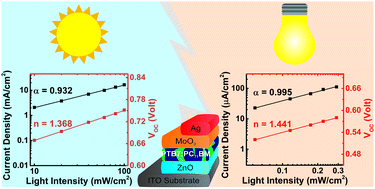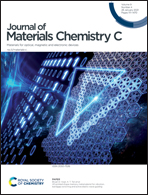The effect of ZnO preparation on the performance of inverted polymer solar cells under one sun and indoor light†
Abstract
In this work, we have investigated in depth the effect of a ZnO layer in between ITO and the active layer of PTB7:PC71BM-based polymer solar cells on the device performance under 1 sun and indoor light conditions. Under 1 sun illumination, the PSCs with ZnO nanoparticles show the highest efficiency of 8.33%, which is nearly 14% more compared to the efficiency of the PSCs with ZnO prepared by the sol–gel method due to the shifting of open-circuit voltage (Voc). The PSCs with ZnO nanoparticles show better carrier transport, collection efficiency, reduced bi-molecular recombination, trap-assisted recombination, and charge accumulation as evident from the measurements of light intensity-dependent short circuit current density, Voc, and bulk capacitance of the device. The chemical capacitance extracted from impedance measurements and the trap depth can thoroughly explain the difference in Voc, i.e. the shift of energy level and carrier recombination are strongly dependent on the preparation methods of ZnO. Moreover, all the devices show similar performance under indoor light except the PSCs with ZnO prepared by the sol–gel method. The ZnO prepared by the sol–gel method could induce the trap-assisted recombination affecting Voc of the device and resulting in the decrease of its indoor performance. However, we believe that these results might provide a good pathway for the development of polymer solar cells for applications under sunlight and indoor light conditions.



 Please wait while we load your content...
Please wait while we load your content...